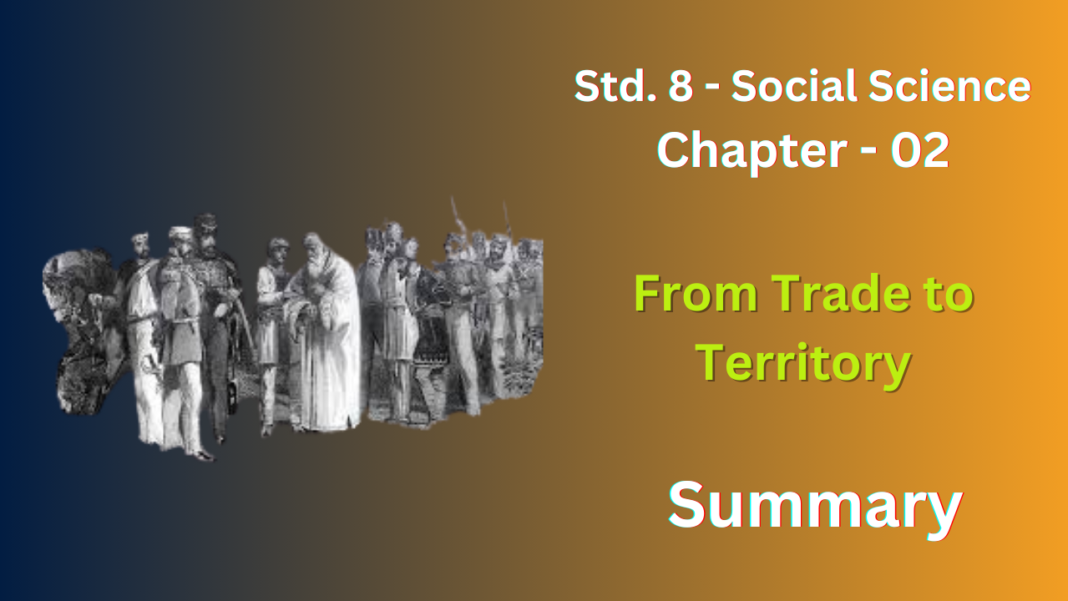NCERT Solutions for Class 8 History Chapter 2
The chapter “From Trade to Territory” in your 8th grade history book explores how the British East India Company, initially focused on trade, gradually gained political power in India. Here’s a quick summary:
- The Arrival: The East India Company arrived in India for trade purposes, securing a charter from the British Queen and permission from Mughal emperors.
- From Trade to Power: The Company didn’t just trade; they aimed for more control. They exploited weaknesses in the Mughal Empire, like conflicts with regional kingdoms, to gain privileges and territories.
- Key Events: The chapter might discuss specific events like the Battle of Plassey (1757), where the Company’s victory over a local ruler marked a turning point.
- Company’s Motives: It explains the Company’s desire for political control. They wanted to eliminate competition, establish trade monopolies, and maximize profits.
- Impact on India: The chapter might touch upon the consequences of the Company’s growing power for Indian rulers and people.
In essence, this chapter highlights the shift in the East India Company’s ambitions from trade to territorial control, laying the groundwork for eventual British colonialism in India.
NCERT Solutions for Class 8 History Chapter 2
Exercise
1. Match the following:
| Column I | Column II |
| Diwani | Tipu Sultan |
| Tiger of Mysore | Right to collect land revenue |
| Faujdari adalat | Sepoy |
| Rani Channamma | Crimical Court |
| Sipahi | Led an anti-British movement in kitoor |
Ans :
| Column I | Column II |
| Diwani | Right to collect land revenue |
| Tipu Sultan | Tiger of Mysore |
| Faujdari Adalat | Criminal Court |
| Sepoy | Sipahi (both terms refer to Indian soldiers employed by European powers) |
| Rani Channamma | Led an anti-British movement in Kittur |
2. Fill in the blanks:
(a) The British conquest of Bengal began with the Battle of …………
(b) Haider All and Tipu Sultan were the rulers of …………..
(c) Dalhousie implemented the Doctrine of ……………
(d) Maratha kingdoms were located mainly in the part of …………… India.
Ans :
(a) The British conquest of Bengal began with the Battle of Plassey.
(b) Haider Ali and Tipu Sultan were the rulers of Mysore.
(c) Dalhousie implemented the Doctrine of Lapse.
(d) Maratha kingdoms were located mainly in the western part of India.
3. State whether true or false:
(a) The Mughal empire became stronger in the eighteenth century.
(b) The English East India Company was the only European company that traded with India.
(c) Maharaja Ranjit Singh was the ruler of Punjab.
(d) The British did not introduce administrative changes in the territories they conquered.
Ans :
(a) False. The Mughal Empire weakened in the eighteenth century.
(b) False. Other European companies like the French and Dutch also traded with India.
(c) True. Maharaja Ranjit Singh ruled Punjab in the early 19th century.
(d) False. The British implemented new administrative systems in their conquered territories.
4. What attracted European trading companies to India?
Ans : European trading companies were lured to India by a combination of factors:
- Lucrative Goods: India produced highly sought-after goods in Europe, like spices (pepper, cloves, cardamom, cinnamon) and textiles (silk, cotton muslin). These items fetched high prices in European markets, promising significant profits.
- Weakened Trade Routes: The traditional land routes to Asia were often disrupted by conflict and instability. European powers sought sea routes to bypass these obstacles and establish direct trade with India.
- Demand for Luxury Goods: As European economies grew, a taste for luxury goods like Indian textiles and spices flourished among the wealthy. This growing demand fueled the desire for a direct trade link with India.
- Weakness of Mughal Empire: The decline of the Mughal Empire in the 18th century created political instability in India. European companies exploited this to their advantage, negotiating better trade deals and gaining political influence with local rulers.
5. What were the areas of conflict between the Bengal Nawabs and the East India Company?
Ans : Several key areas fueled conflict between the Bengal Nawabs and the East India Company:
- Trade Privileges: The Company wanted expanded trade rights and fewer restrictions. They misused privileges like “dastak” (exemption from customs duties) for personal gain, harming both the Nawab’s revenue and Indian merchants.
- Tributes and Taxes: The Nawabs demanded hefty tributes from the Company for their trading rights. The Company, however, resisted paying taxes on their growing trade profits.
- Military Concerns: The Company’s military presence and fortification expansion threatened the Nawabs’ authority. The Nawabs feared the Company’s growing military might.
- Disrespect and Interference: The Company’s officials sometimes showed disrespect towards the Nawabs. They also interfered in local politics, creating friction with the Nawabi administration.
- Competition and Exploitation: The Company’s dominance in trade led to accusations of unfair competition and exploitation of Indian resources. This hurt the Bengal economy and the Nawab’s income.
6. How did the assumption of Diwani benefit the East India Company?
Ans : The assumption of Diwani by the East India Company in 1765 granted them significant advantages, fundamentally transforming their position in India. Here’s how it benefited them:
- Financial Windfall: The Diwani gave the Company the right to collect land revenue from Bengal, a vast and wealthy province. This provided them with a massive source of income to finance their trade, maintain their army, and send profits back to Britain.
- Reduced Dependence: With direct control over tax collection, the Company no longer relied solely on the Nawab of Bengal for revenue. This lessened their dependence on the local ruler and strengthened their own financial independence.
- Military Power: The revenue from Bengal allowed the Company to significantly expand and strengthen their military presence in India. This military might helped them subdue rival European companies and assert their dominance in the region.
- Trade Monopoly: By controlling Bengal’s administration, the Company could influence trade policies and potentially manipulate markets. This could give them an unfair advantage and potentially eliminate competition from Indian merchants.
- Political Leverage: The Diwani enhanced the Company’s political influence in Bengal. They could potentially influence the Nawab’s decisions and gain greater control over the province’s administration.
7. Explain the system of ‘subsidiary alliance’.
Ans : The Subsidiary Alliance system, implemented by the British East India Company, was a cunning tactic for expanding their control in India. It aimed to achieve dominance without the high costs and complexities of direct military conquest. Here’s how it worked:
Sweeteners and Strings Attached:
- The Company lured Indian rulers with promises of protection against external enemies and internal rebellions. This security might have been tempting, especially for rulers facing immediate threats.
- However, this “protection” came with a hefty price tag. Indian states were forced to:
- Disband their own armies: This left them completely reliant on British military support, essentially dismantling their ability to defend themselves independently.
- Host British troops: The Indian states had to pay for the upkeep of these British forces stationed within their territories, placing a significant financial burden on their economies.
- Sever foreign policy ties: Indian rulers were forbidden from making alliances or declaring war on other powers without British consent. This severely restricted their sovereignty and ability to act independently.
The Bitter Consequences:
- Weakened Militaries: By dismantling their own armies, Indian states became militarily impotent, utterly dependent on the British for defense.
- Economic Strain: The constant financial drain of maintaining British troops crippled Indian treasuries, hindering their economic development and stability.
- British Hegemony: The restrictions on foreign policy essentially made Indian states puppets of the British. The Company could now dictate their actions and influence their internal affairs.
8. In what way was the administration of the Company different from that of Indian rulers?
Ans : The administration of the East India Company differed from that of Indian rulers in several key ways:
- Structure: Indian rulers often had a decentralized administration with regional governors or powerful zamindars (landlords) wielding significant local control. The Company, in contrast, established a more centralized system with a hierarchy of officials answerable to a central authority in Calcutta (present-day Kolkata).
- Laws and Regulations: Traditional Indian administration relied heavily on customary laws and varied across regions. The Company introduced a more codified legal system, though it often applied differently to Europeans and Indians.
- Focus: Indian rulers primarily focused on revenue collection and maintaining order. The Company, however, was driven by profit maximization. Their administration emphasized trade regulations, resource extraction, and policies that benefited their commercial interests.
- Military: Indian rulers typically maintained large standing armies or relied on a network of smaller regional forces. The Company’s military comprised a mix of Indian sepoys (soldiers) and British troops. This allowed them to leverage Indian manpower while maintaining control through a core of British officers.
- Bureaucracy: Indian administration often involved a less formalized bureaucracy. The Company, on the other hand, gradually developed a more bureaucratic system with defined roles and procedures.
9. Describe the changes that occurred in the composition of the Company’s army.
Ans : The composition of the East India Company’s army underwent significant changes throughout the 18th and 19th centuries. Here’s a breakdown of the key transformations:
Early Composition (18th Century):
- Inheritance from Mughals: Initially, the Company’s army resembled the Mughal forces, consisting of cavalry and infantry regiments.
- Focus on Peasants: The Company recruited soldiers from the peasant class, similar to the Mughal practice.
- Limited Training: These early soldiers received minimal formal training, relying more on experience and traditional battle tactics.
Shifting Strategies (19th Century):
- Decline of Cavalry: As warfare technology evolved, the importance of cavalry diminished. The Company gradually reduced its cavalry units, favoring a more musket-reliant infantry.
- Emphasis on Firearms: Soldiers were increasingly equipped with muskets and matchlocks, reflecting the growing importance of firepower in European warfare.
- Standardization and Discipline: The Company introduced stricter training methods and instilled European-style discipline in its soldiers. This aimed to create a more professional and unified fighting force.
- Sepoy Recruitment: The Company heavily relied on Indian sepoys, soldiers recruited from various social groups within India. This strategy provided a large pool of manpower while keeping costs relatively low.
Later Developments:
- British Officers: The Company maintained a core of British officers who held command positions and ensured loyalty to the Company’s interests.
- Uniform Culture: A uniform military culture began to develop, with sepoys adopting European-style uniforms, drills, and regulations. This aimed to create a sense of unity and control within the army.
10 . After the British conquest of Bengal, Calcutta -grew from a small village to a big city. Find out about the culture, architecture, and the life of Europeans and Indians of the city during the colonial period.
Ans : The British conquest of Bengal in the mid-18th century transformed Calcutta from a sleepy village into a bustling metropolis. However, this growth wasn’t uniform. Calcutta became a city of stark contrasts, reflecting the social and cultural divides of the colonial era.
Culture:
- European Enclave: Europeans, primarily British officials and businessmen, lived a life largely segregated from the Indian population. They enjoyed social gatherings at clubs, attended horse races and theatrical performances, and indulged in Western cultural pursuits.
- Indian Heritage: Despite the European influence, Calcutta remained a vibrant center of Indian culture. Traditional festivals like Durga Puja and Holi were still celebrated with fervor. Classical music and dance thrived, and Bengali literature flourished with figures like Rabindranath Tagore.
- Fusion and Change: The city also witnessed a cultural exchange. New literary forms like Bengali prose emerged, and Indian musicians began incorporating Western instruments into their performances.
Architecture:
- European Dominance: The cityscape reflected European dominance. Grand buildings like the Victoria Memorial and the General Post Office were built in Victorian and Gothic Revival styles, showcasing British power and architectural traditions.
- Indian Influence: However, Indian architectural elements weren’t entirely absent. The use of verandas and courtyards in some colonial buildings hinted at a subtle blend of styles.
- Segregation in Housing: European residences, often spacious bungalows, were located in distinct areas like Chowringhee, separated from the densely populated Indian quarters.
Life in Calcutta:
- European Privilege: Europeans enjoyed a life of relative comfort and luxury. They had access to modern amenities like clean water, sanitation facilities, and well-maintained roads, often lacking in Indian areas.
- Indian Hardships: In contrast, life for most Indians was marked by poverty and overcrowding. Sanitation was poor, housing inadequate, and access to healthcare limited. The burden of taxation often fell heavily on the Indian population.
11. Collect pictures, stories, poems, and information about any of the following – the Rani of Jhansi, Mahadji Sindhia, Haidar Ali, Maharaja Ranjit Singh, Lord Dalhousie, or any other contemporary ruler of your region.
Ans :
- Rani Lakshmibai(19 November 1828 – 18 June 1858) was one of the leading figures of the Indian Rebellion of 1857 against the rule of the British East India Company.
- She was the regent of the Jhansi State from 1854 to 1858 after the death of her husband Maharaja Gangadhar Rao Newalkar.
- Lakshmibai was known for her courage, leadership, and resistance against British rule.
- She is a folk hero in India and a symbol of Indian nationalism.
Here is a famous poem written about Rani Lakshmibai by Subhadra Kumari Chauhan:
Jhansi ki Rani Laxmibai,
Bharatiyon ki Abhimaan
Angreziyon se lad kar
Martya hui veerangana
Mahadji Sindhia (1730 – 1794)
- A prominent Maratha statesman and military leader who rose to power in the mid-18th century.
- Established the Scindia Dynasty in Gwalior, central India.
- Played a key role in expanding the Maratha Empire and emerged as the de facto leader of the Maratha Confederacy after defeating the Mughals at Panipat in 1761.
- Known for his diplomatic skills and his ability to combine military prowess with strategic alliances.
Haider Ali (1721 – 1782)
- The ruler of the Kingdom of Mysore in southern India from 1761 to 1782.
- Known for his modernization of the Mysore army, introducing a rocket artillery unit that impressed even European observers.
- Successfully resisted British expansion in southern India for many years. His son, Tipu Sultan, continued this resistance.
Maharaja Ranjit Singh (1780 – 1839)
- The founder of the Sikh Empire in northwest India, ruling from 1799 to 1839.
- Earned the title “Sher-e-Punjab” (Lion of Punjab) due to his military leadership and successful campaigns.
- United various Sikh misls (independent Sikh groups) under his rule and established a strong centralized Sikh Empire.
- Known for his religious tolerance and for employing people from diverse backgrounds in his administration.
Lord Dalhousie (1812 – 1860)
- The Governor-General of British India from 1848 to 1856.
- Implemented a policy of “Doctrine of Lapse,” annexing Indian princely states if the ruler died without a legitimate heir. This policy was seen by many Indians as a violation of their traditional rights and contributed to growing resentment against British rule.
- Oversaw a massive expansion of British territory in India through annexation and military conquest, including Punjab after the Anglo-Sikh Wars.
- Introduced various social and administrative reforms, including a modern railway system and a telegraph network. However, his rule is also remembered for its authoritarianism and the seeds of discontent it sowed.
NCERT Solutions for Class 8 History Chapter 2 From Trade to Territory
FAQ’s
What is the main focus of NCERT Solutions for Class 8 History Chapter 2?
The main focus of NCERT Solutions for Class 8 History Chapter 2 is on the transformation of the British East India Company from a trading entity to a territorial power in India, as discussed in “From Trade to Territory.”
How did the British East India Company transition from trade to territory?
The British East India Company transitioned from trade to territory by leveraging military power and strategic alliances, gradually taking control of Indian territories, as detailed in NCERT Solutions for Class 8 History Chapter 2 From Trade to Territory.
Why is the Battle of Plassey significant in NCERT Solutions for Class 8 History Chapter 2?
The Battle of Plassey is significant because it marked the beginning of British political control in India, a pivotal event covered in “From Trade to Territory” in NCERT Solutions for Class 8 History Chapter 2 From Trade to Territory.
What role did the Doctrine of Lapse play according to NCERT Solutions for Class 8 History Chapter 2?
The Doctrine of Lapse was a policy used by the British to annex Indian states without a male heir, significantly expanding their territory, as explained in NCERT Solutions for Class 8 History Chapter 2.
How do NCERT Solutions for Class 8 History Chapter 2 help in understanding colonial expansion?
NCERT Solutions provide detailed explanations and context for the events and policies that facilitated British colonial expansion in India, helping students understand the complex dynamics of “From Trade to Territory.”
What was the impact of British territorial expansion on Indian rulers, as discussed in NCERT Solutions for Class 8 History Chapter 2?
British territorial expansion led to the decline of many Indian rulers and kingdoms, reshaping the political landscape of India, a key point highlighted in “From Trade to Territory” in NCERT Solutions for Class 8 History Chapter 2.
How did trade policies change with British control, according to NCERT Solutions for Class 8 History Chapter 2?
With British control, trade policies became heavily skewed in favor of British interests, disrupting traditional Indian economies and trade practices, as described in NCERT Solutions for Class 8 History Chapter 2.
What were the consequences of the British East India Company’s rule on Indian society, as per NCERT Solutions for Class 8 History Chapter 2?
The consequences included socio-economic disruptions, loss of traditional authority, and the imposition of new administrative systems, all of which are discussed in “From Trade to Territory” in NCERT Solutions for Class 8 History Chapter 2.
How can students benefit from studying NCERT Solutions for Class 8 History Chapter 2?
Students can benefit by gaining a comprehensive understanding of the historical processes and events that led to British dominance in India, helping them appreciate the complexities of colonial history as outlined in “From Trade to Territory.”









